Beyond Hybrid: Why the Next Generation of Workplace Design Must Resonate
By: Jeff Cumpson
The modern workplace isn’t just competing with other offices; it must compete against all of the places where we work today: the comfort of home, the buzz and hospitality of coffee shops, and the ease of hotel lobbies and other public spaces.
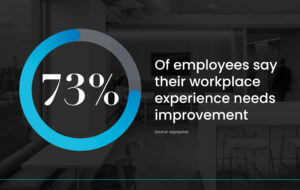
In today’s hybrid reality, 73% of employees say their workplace experience needs improvement (Appspace). That’s not simply a design problem—it’s a missed opportunity. To attract and retain top talent, boost performance, and unlock real estate value, workplaces must resonate. They must harmonize with how people naturally work and amplify what makes in-person experience worth showing up for. The right spaces make people feel connected to their colleagues and culture, in the flow as they move through their day, healthy in both body and mind, and valued as individuals.
At NELSON Worldwide, we define a resonant workplace as one that does more than just support the workday, but energizes it.
The Energy Imperative
Workplace energy has become the new barometer of success. A well-designed space can’t deliver if it sits empty because teammates opt to work elsewhere. We’ve found that the ideal range for high vibrancy—the level at which energy fuels culture and productivity—occurs when occupancy sits between 60% and 90%. But hitting that target means understanding more than just headcount. It requires deep insight into how teams work, when they collaborate best, and what kind of spaces support their rhythm.
Too often, organizations focus on enforcing attendance policies when they should be investing in alignment—ensuring space, policy, and behavior are in tune. When energy is up, collaboration, engagement, creativity follow.
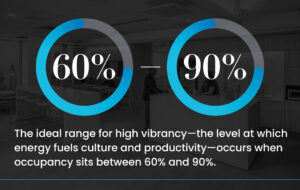
The Power of Purpose
There’s something intangible yet vital that gets lost in remote work: a sense of purpose. While virtual meetings keep the work moving, they can distance employees from the deeper “why” behind their contributions. That disconnect carries weight. When people feel connected to an organization’s purpose, the likelihood of retention increases, with Gallup reporting an impressive 15% increase in productivity.
Purpose, however, isn’t simply communicated in a memo—it’s experienced. The most resonant workplaces embed purpose into every square foot, from brand storytelling that reflects mission and values to spatial cues that reinforce company culture. In fact, 75% of employees see themselves as brand ambassadors. But to act like one, they need a physical space that reflects the brand they believe in.
Removing Friction, Creating Flow
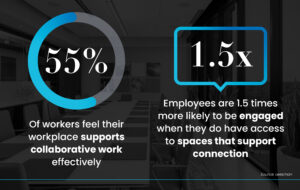
A resonant workplace enables people to do their best work without barriers. Many office environments create more friction than flow—whether it’s tech that won’t connect, poor acoustics, or the absence of quiet zones for focus. According to workplace experience research firm Leesman, only 55% of workers feel their workplace supports collaborative work effectively, yet, employees are 1.5 times more likely to be engaged when they do have access to spaces that support connection.
Flow doesn’t happen by accident. It’s the result of thoughtful design that responds to how people move through their day—offering seamless transitions between collaboration and concentration, between virtual and physical modes of working. It’s also about eliminating avoidable pain points: 36% of employees say slow or outdated technology is a major deterrent to returning to the office. Spaces designed with acoustics in mind are a unique advantage of the office, supporting both collaboration and the need to step away for video calls or focused conversations.
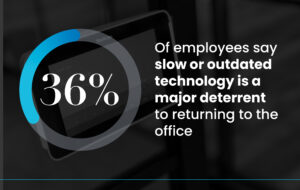
Wellness as Strategy
Wellness has moved from perk to priority. In 2024, McKinsey estimated the U.S. wellness industry to be worth $480 billion, growing by 5% to 10% annually. More telling, 82% of Americans now consider wellness a key priority—on par with global trends seen in the UK and China.
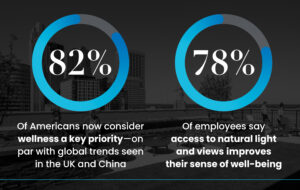
This demand for wellness must be reflected in workplace design. Features like natural light, greenery, ergonomic furniture, and calming environments aren’t just nice-to-haves; they’re performance drivers. Studies show biophilic design can boost productivity by 15%, while poor ergonomics can reduce it by up to 17%. And 78% of employees say access to natural light and views improves their sense of well-being.
Designing for wellness means making health effortless, baked into the workplace experience from the moment employees walk in, whether they’re settling into a quiet zone, refueling at a juice bar, or taking a break in a restorative outdoor space.
Making People Feel Valued
The final layer of a resonant workplace is emotional. People want to feel seen, supported, and appreciated—and that feeling needs to be reinforced not just by managers, but by the space itself.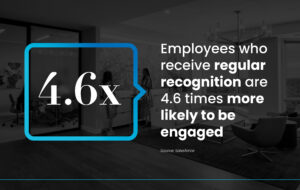
Recognition, when made visible through the built environment, has real impact. Salesforce reports that employees who receive regular recognition are 4.6 times more likely to be engaged. Whether it’s an achievement wall that celebrates team wins or communal spaces that foster social belonging, workplaces can make culture tangible in a way no remote work platform ever could.
Investments like a welcoming cafeteria, a fitness center, or thoughtful outdoor space aren’t just amenities. They’re signals that leadership values its people—and when people feel valued, they perform at a higher level.
A Strategic Asset, Not Just a Space
In a market defined by talent wars, real estate pressure, and shifting employee expectations, the workplace is no longer a cost center—it’s a competitive differentiator. A resonant workplace does more than function. It connects people to purpose, supports fluid workstyles, invests in well-being, and broadcasts culture.
For more than 40 years, our workplace team at NELSON Worldwide has helped organizations design spaces that don’t just meet business goals—they make people feel something. That’s what keeps them coming back. That’s what makes a workplace resonate.

Let's Connect:
Jeff Cumpson,
Jeff Cumpson is Director of Sales Marketing at NELSON Worldwide. With experience in strategy and messaging, he works closely with NELSON's designers to understand their work, where they can deliver value, and how they can communicate that to clients. A former collegiate athlete, he is still inspired by the positive impact sports can have in people’s lives. Reach out to him at Jeff Cumpson.